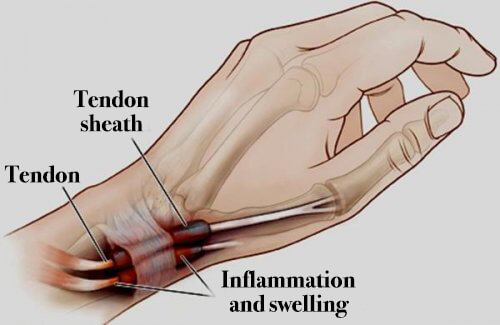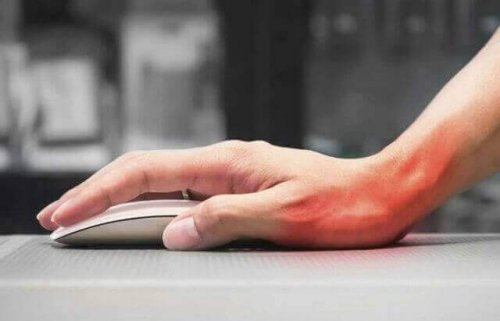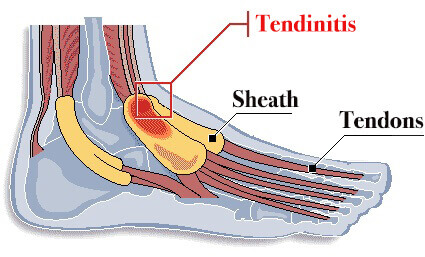Tenosynovitis: Inflammation in the Hands and Feet


Written and verified by psychologist Valeria Sabater
The word tenosynovitis may sound a little strange. But in reality, it’s a problem that many of our readers will become familiar with at some point.
It’s the inflammation of the lining of the protective sheath that surrounds the tendon. It’s painful, debilitating and is centralized in the hands and feet.
It may occur as sudden swelling of the skin and redness of the skin may occur as well. Despite not having suffered any injury, the pain is intense and debilitating, even when at rest.
Experts tell us that getting an early diagnosis is vital. This will prevent the inflammation from further damaging tendons and their sheaths and causing even more problems.
If you are feeling discomfort, consult a specialist. Below, we’ll tell you everything you need to know about tenosynovitis.
Tenosynovitis: debilitating joint pain
In order to understand what tenosynovitis is, let’s take a look at a tendon. This perfect structure anchors the muscles in our hands to the bone.
The tendon is covered in a sheath, the synovial membrane, which protects and isolates the tendons. This is precisely where the inflammation and pain occur.
What’s notable right away about this condition is that it affects the flexor muscles. This means the first symptoms occur when moving your hands or walking.
It begins as a slight pain, but slowly it develops into inflammation, swelling, and even fever.

Who is at risk?
Tenosynovitis of the upper extremities tends to affect women more. Also, athletes or those who work in manual labor, like tailors, butchers, and even dentists.
What are the symptoms?
- Pain in the wrist, ankle, sole of the foot, or heel
- Redness or swelling that lasts for days, even when resting
- Fingers and toes “creak” when moving
- Small bumps on the fingers and toes due to infection
- Handling objects, walking, and doing daily tasks takes a lot of effort and causes a lot of discomfort

What causes it?
The main causes of inflammation of the synovial sheath are repetitive movements of the hands and feet. Poor posture also plays a contributing role.
Every one of these repetitive and constant movements causes excessive friction between the tendon and bone. Repetitive movement and small injuries to the sheath that surrounds the tendon can slowly lead to swelling.
De Quervain syndrome
One of the most common injuries associated with tenosynovitis is De Quervain syndrome.
It’s a painful inflammation of the tendons in the thumbs.
- Everyday tasks like picking up a small child, sewing, typing, or even playing the piano can cause it.
- It can also be from physical injury to the thumb, such as a small, subtle tear in the tendon. It may be painful, but as time passes this tissue scars.
- The scar tissue can prevent the tendon from functioning well. This is something to keep in mind that can also cause De Quervain syndrome.

Treatment for chronic tenosynovitis
The main treatment goal is to reduce inflammation. Your doctor will discuss the best course of treatment for you.
Combining drugs with physical rehabilitation is the most common treatment.
- You must keep your hand or foot immobile for a few days with a splint or bandage.
- Hot and cold therapy is also effective.
- Soaking the affected area in warm rosemary water will relax your muscles and relieve inflammation.
- Ginger tea is also highly recommended. It reduces pain and swelling.
- Physical therapy is a huge help for treating tenosynovitis. You’ll also learn exercises that you can do at home to restore strength and mobility.
These basic treatments are to reduce stress and pressure on the tendons.
Read more: How to Prepare Ginger as a Cough Remedy
Lastly, it’s important to remember that it can recur, so you’ll need to pay attention to your posture and movements.
Seek professional treatment, avoid overworking and remember that your joints and tendons are amazing structures that need more care than you think.
All cited sources were thoroughly reviewed by our team to ensure their quality, reliability, currency, and validity. The bibliography of this article was considered reliable and of academic or scientific accuracy.
- Joseph J. Biundo, MD, Clinical Professor of Medicine, Tulane Medical Center. Tendinitis y tenosinovitis. https://www.msdmanuals.com/es-ve/professional/trastornos-de-los-tejidos-musculoesquel%C3%A9tico-y-conectivo/afecciones-de-bolsas-sinoviales,-m%C3%BAsculos-y-tendones/tendinitis-y-tenosinovitis
- Arthritis Foundation. Tenosinovitis y Contractura de Dupuytren. http://espanol.arthritis.org/espanol/disease-center/tenosinovitis/
- American Society for Surgery of the Hand (ASSH). Síndrome de De Quervain – De Quervain Syndrome. (2014). http://www.assh.org/handcare/espanol/sindrome-de-quervain
This text is provided for informational purposes only and does not replace consultation with a professional. If in doubt, consult your specialist.








